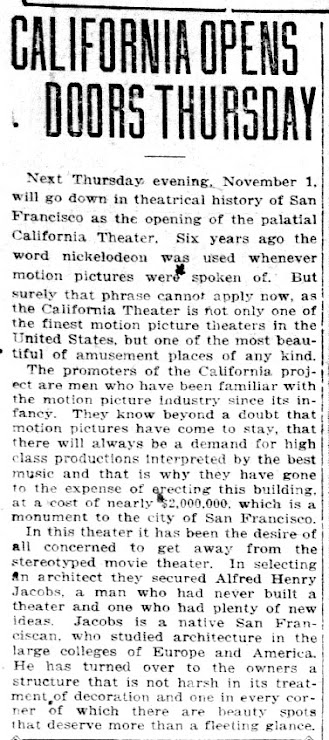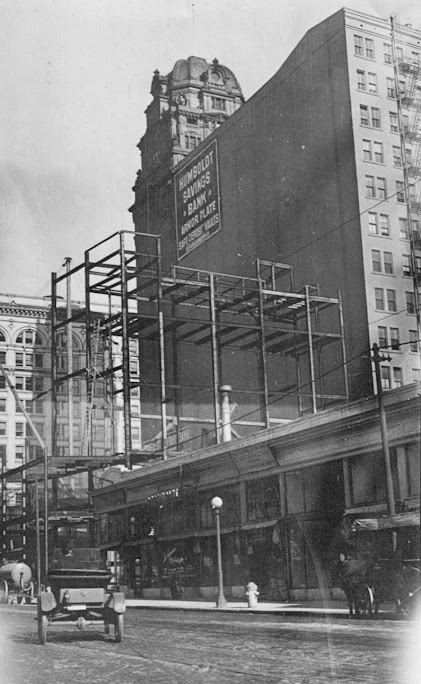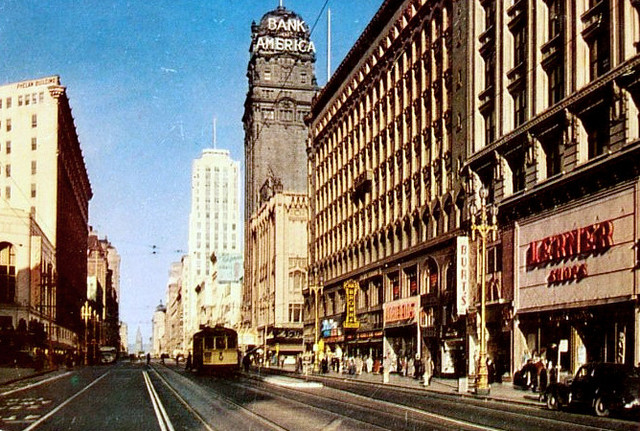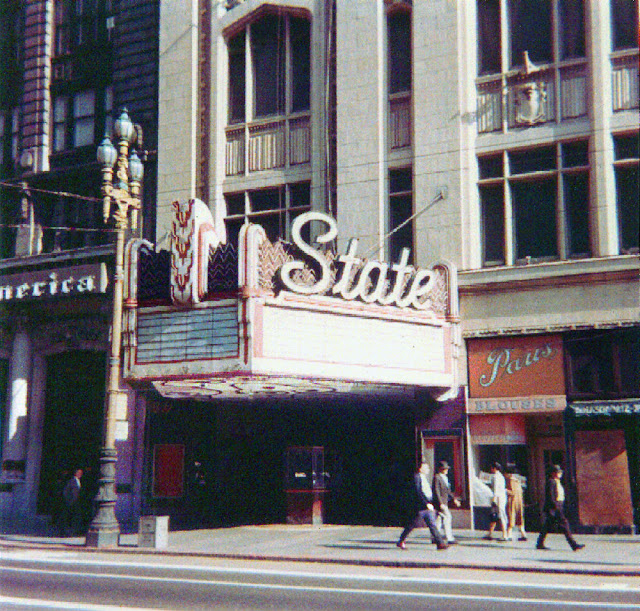Opened: November 1, 1917 as the California Theatre. It was on the southeast corner of 4th and Market. Previously on the site was a building housing the Pastime Theatre. In this photo the theatre is playing "By Right of Purchase"
with Norma Talmadge, a film that opened at the theatre on Sunday, March 24, 1918. Note that second entrance on 4th St. Thanks to Bennett Hall for sharing the photo on Flickr.
Architect: Alfred Henry Jacobs. In 1918 Jacobs would do some renovation work at the Portola for the same company that owned the California. In 1922 he would design the Curran Theatre.
The California and the Granada, another Jacobs project, were discussed in "Two San Francisco Motion Picture Theatres," a six page article by Mr. Jacobs that appeared in the October 1922 issue
of Architectural Forum. It's on the site HathiTrust, scanned from a copy at the
Princeton University collection. Thanks to Bob Foreman for locating it.
The full article appears near the top of the page about the Granada Theatre.
Floor plans from the Architectural Forum article. On the plan on the left note the booth at the back of the main floor. The second and third floors along Market St. were devoted to restrooms and lounge areas. Above that note how on the balcony plan the seats went all the way back to Market St. facade.
Seating: 2,780 originally. 2,133 in its later years.
The Organ and its lift: It was a Wurlitzer-Hope-Jones instrument with the console mounted on a hydraulic lift that could come up to stage level. This was evidently the first organ lift in the country. The instrument and the lift were discussed in "California Sets Pace For West," an article about the theatre beginning on page 2805 of the October 20, 1917 Motion Picture News:
"Among the chief features of the building is the largest orchestral organ ever constructed. This instrument, a Wurlitzer organ, costing $54,000, is so large that it was impossible to group the pipes in one section. It has been divided into six chambers around the building, two on each side, with the echo organ placed in the attic space and the main organ carried over the proscenium the entire width of the interior. Dr. Bruce Gordon Kinsley, the famous San Francisco organist, will be master of the keyboard, and will be stationed at a console in the orchestra pit, which console is placed on an elevator so that during the organ recital he may be raised into view of the audience. So complex and intricate are the organ controls that a special relay room containing them has been placed in the basement. This room is enclosed in plate glass, and will be on exhibition for the audience."
A story about the theatre's steel work that appeared in the March 10, 1917 issue of Engineering Record. Thanks to Bob Ristelhueber for finding the article.
This article appeared in the October 27, 1917 San Francisco Call and Post. Thanks to Art Siegel for locating it via the California Digital Newspaper Collection website. He calls our attention to their description of the architect, Alfred Henry Jacobs, as "a man who had never built a theater and one who had plenty of new ideas."
The new theatre was profiled in a 2+ page article in the December 22, 1917 issue of Moving Picture World that's on Internet Archive:
"Coast Theatre Mechanically Perfect." The article below detailed the theatre's electrical and mechanical systems and appeared in the April 20, 1918 issue of the trade magazine Motography.
Soon the California was being operated by Wobber Brothers and managed
by Jack Partington, who had worked for the Graumans at the Imperial. A February 13, 1926 article in Exhibitors Herald was about Partington. Thanks to Bob Foreman for finding it on Internet Archive. The Herald noted:
"After
the Graumans sold the Imperial to Wobber Brothers and it was merged
with the California theatre, Partington was placed in charge of both
houses. When the Rothschild [sic] interests took over the two houses and
built the Granada, Partington was given charge of the three theatres.
This position he held until his transfer to Los Angeles [in 1926]."
A January 1937 calendar from the Jack Tillmany collection. He notes: " Still pretty depressed and even more depressing! 2/3 changes per week! Bargain Matinees 20 cents; Evenings (all seats) 30 cents (no extra charge for loges). YIKES! Bank Night every Thursday; Ten-O-Win every Monday!"
It was renamed the State Theatre with a reopening December 31, 1941.
Closing: It closed as a film house March 2, 1954. ABC-Paramount was the last operator. It was then occasionally rented out for revival meetings and other events.
Status: The theatre was demolished in beginning in late 1961. A November 27 item in Boxoffice about the uncertain future of the Fox noted that demolition of the State was already underway. After being a parking lot for a few years a building for the clothing store Roos-Atkins rose on the site. It's now occupied by a Ross Dress For Less.The California Theatre in the Movies: About 45 seconds into "Fog Over Frisco" (Warner Bros., 1934) there are a couple brief shots of Market and 4th, showing the California Theatre. The film stars Bette Davis and Donald Woods. Thanks to Jack Tillmany for the data.
Photos of the ticket lobby:
One of three photos of the theatre appearing in the August 1918 issue of The Architect. Note the elaborate frieze above the entrance doors. The issue is on Internet Archive.
"Dominant Motif of Central Panel of Frieze in the Main Entrance Lobby..." The photo appeared in a "Portfolio of Photographs of the Frieze in the Main Entrance Lobby of the California Theatre" in the November 1917 issue of Architect and Engineer. It's on Internet Archive. The paintings were done by Ray F. Coyle.
"Portion of Central Panel of Frieze in Main Entrance Lobby..." Photo: Architect and Engineer - November 1917
"Central Motif Left Hand Panel in Main Entrance Lobby..." And by that they mean the ticket lobby outside. Photo: Architect and Engineer - November 1917
Lobby and lounge areas:
A fountain in the main lobby. Note the exit doors in the mirror. The November 1917 photo is from the Jack Tillmany collection. He comments: "Cupid Amongst the Ferns. I'm sure it's just an unfortunately placed fern frond, but it almost looks like Cupid is a little TOO enthusiastically anatomically correct."
The loggia. "Instead of forcing hundreds to stand in line waiting, an immense loggia, 100 feet long and 25 feet wide, on the Market Street side, is provided with lounging chairs; in fact is fitted up as an indoor garden to accommodate those waiting for seats."
The photo and comment photo appear with "California Sets Pace For West," an article about the theatre beginning on page 2805 of the October 20, 1917 Motion Picture News. Also see the article's continuation on pages 2806 and 2807. Thanks to Bob Foreman for locating this on Internet Archive. Ignore the auditorium photo with the article as it's some other theatre.
A copy of the photo from the Jack Tillmany collection is on the San Francisco Public Library website. A version appearing with an article profiling the new theatre in the December 22, 1917 issue of Moving Picture World is on Internet Archive. Thanks to Bob Ristelhueber for finding that article for a post on the BAHT Facebook page.
A detail of the fountain seen at the far end of the balcony plaisance in the previous photo. The photo from the Jack Tillmany collection appears on the San Francisco Public Library website.
The photo also appears as a plate with "Two San Francisco Motion Picture Theatres," the article about the Granada and California theatres by Alfred Henry Jacobs in the October 1922 issue of Architectural Forum. Thanks to Bob Foreman for locating it on the HathiTrust site. It's also on the Granada Theatre page.
A 1920s view toward the rear of the house. Note the main floor booth. It's a photo from the Jack Tillmany collection.
More exterior views:
This 1917 postcard view shot during a parade caught the California Theatre on the right while still under construction. Thanks to Glenn Koch for spotting the card on eBay. That's the Portola Theatre marquee in the center of the image.
A 4th & Market pre-opening photo appearing with an article profiling the new theatre in the December 22, 1917 issue of Moving Picture World. Note the unfinished marquees. It's on Internet Archive. Thanks to Bob Ristelhueber for finding the article for a post of six photos on the BAHT Facebook page.
A mid-November 1917 photo from the Jack Tillmany collection. The new theatre is running "Arms and the Girl" with Billie Burke. Jack calls our attention to the fact that here the storefronts are still vacant.
A January 4, 1918 look at the new theatre. Thanks to Bob Ristelhueber for finding the photo in the SFMTA Archives for a post on the Facebook page San Francisco Remembered.
A look east on Market at 4th during the last week of May 1918. Beyond the California Theatre on the corner we get a glimpse of the Portola Theatre as well. The photo, from the Emiliano Echeverria / Randolph Brandt Collection, appears on the Open SF History Project website.
Another 1918 "Selfish Yates" shot. Thanks to Jack Tillmany for locating this one for a post on the BAHT Facebook page. He comments: "The Muni Line K had just recently established downtown service through Twin Peaks Tunnel on 3 February 1918."
A photo taken the last week of August 1918 from the Jack Tillmany collection. A smaller version appears on the San Francisco Public Library website.
An early corner view, part of a lovely set Wayne Miller found at a flea market. The set is on the Facebook page San Francisco Remembered.
A photo with Charles Ray in "Paris Green" on the marquee. It played the last week of May 1920. Thanks to Martin Treu for the photo on his Signs, Streets and Storefronts Facebook page. He comments that the design "demonstrated how well a theatre's graphic identity could be seamlessly integrated with the architecture. Here, the architect carried the lines of the facade up to an extended parapet which incorporates lettering carefully with the Gothic style tracery. Bravo!"
A June 11, 1922 photo from Jack Tillmany. He comments: "A little promotion: 'The Gray Dawn' was a Gold Rush tale set in Old San Francisco, apparently involving a newspaper called The Bulletin, no relation to the SF rag of the same name, but obviously a good idea for a promo stunt."
A December 1923 photo from the Jack Tillmany collection. He comments: "The usual street work on Market St. Note: The Portola marquee has vanished!"
An October 1924 photo from Jack Tillmany. Note the added readerboard this side of the California's entrance. The big marquee down the block at the left of the photo belonged to the Odeon Theatre. By the time of this photo the space had been repurposed as the Metropolitan Market.
A press photo dated August 13, 1925. The feature is "Not So Long Ago" with Betty Bronson and Ricards Cortez. Thanks to Christopher Snowdon for the photo, a post on the BAHT Facebook page.
The theatre got its picture in the August 28, 1926 issue of Motion Picture News. It's on Internet Archive. They were noting the promotion of a short, "The Bear Cats," on their signage -- which they've helpfully circled for us. The feature at the time was "Volcano" with Ricardo Cortez and Wallace Beery. Thanks to Bob Ristelhueber for finding the photo for a post on the BAHT Facebook page.
The front dressed up for the January 1930 run of "Sally." Note the sign at the top of the image advertising Marilyn Miller, the star of the film.
Another view of the promotion for "Sally." That's the boxoffice on the right. Thanks to Jack Tillmany for finding the photos.
The signage for "Puttin' on the Ritz" in March 1930. The photo is from the Jack Tillmany collection.
The 1934 general strike was the occasion for this photo of the 4th St. marquee from International News Service. Thanks to Glenn Koch for spotting it on eBay. It was sent out with this caption:
"Theatre Closed in Frisco Because of Strike -- As the sign on the marquee indicates, this theatre in San Francisco, like so many others throughout the city, was forced to shut down when the general strike, now gripping the city, was called yesterday morning, July 16th. 200,000 persons went out on strike in sympathy with the 4,000 dock workers whose strike started in May."
No, we're not on Market St. -- on the left we get the theatre's 4th St. marquee as we look south from Market. The photo appears on the Open SF History Project website courtesy of a private collector.
A November 1940 photo from the Jack Tillmany collection. He comments: "The California by now is definitely upgraded from its 1930s woes, but still a secondary venue. 'Wyoming' opened at the Fox in September 1940, and 'Argentine Nights' opened at the Orpheum in September 1940. By November they were paired at the State, much like they would have been at the Embassy, but without the advantage of Ten-O-Win, the Embassy would have held the winning hand.
We know the California offered both Ten-O-Win on Monday and Bank Night on Thursday in 1937, but the question is, were they still doing so in 1940? Note the Gray Line marquee on the old Portola site. For rail fans who might be interested, Market Street Railway's Line #20 provided service to the Southern Pacific Depot to passengers from the Oak Street/Page Street corridor by way of Divisadero and the O'Farrell Street/Ellis Street corridor. Service was abandoned in 1947."
A 1942 look east by Meith Hagel for Life. The State, over on the right, is running "In This Our Life," a May release with Bette Davis along with Hitchcock's "Saboteur," an April release. This photo, and other 40s views that Mr. Hagel took in San Francisco, are on the site Vintage Everyday. Thanks to Ernie Manzo Jr. for spotting the collection.
A late 1942 or early 1943 photo from the Jack Tillmany collection. He comments: "The State has a sub-run of 2 top of the line features; note the banner, provided, along with posters and trailers, by National Screen Service. They were stitched together in the middle, so whatever combination of titles the theatre chose could be sewn together as a single banner. The Portola site is still in operation as the Gray Line Depot."
A May 1943 photo by Ann Rosener looking down Ellis St. to 4th & Market. Thanks to Phil Davies for the post on the Facebook page San Francisco Remembered. The photo also appears in Bennett Hall's collection on Flickr. The theatre had been renamed the State in 1941 -- note that the California letters are off the roof sign and that we no longer have a vertical.
A January 1944 photo from Jack Tillmany. He notes: "'Old Acquaintance' had opened at the Paramount in December 1943 and played three weeks so successfully, it moved over to the State for a 4th week continuing its Market Street first run, typical of that era. The Gray Line seems to have vanished from the Portola site, probably as the result of WWII gasoline rationing impacting its operation."
"Song of Bernadette" at the State in August 1944 after winning four Academy Awards. Note that the theatre is still using milk glass letters. It's a Tom Gray photo from the Jack Tillmany collection. The ticket stubs are also from Jack's collection. A smaller version of the photo appears on the San Francisco Public Library website.
An August 14, 1945 VJ Day photo at 3rd & Market. Note the new readerboard faces. That's the Portola theatre just beyond the State's marquee. The photo appears on a page of VJ Day photos on the website of the Lynchberg, VA News & Advance.
A Time/Life photo taken on VJ Day 1945. Thanks to Bob Ristelhueber for posting it on the BAHT Facebook page.
An October 1947 photo from Jack Tillmany's collection featuring a streetcar decked out to promote the annual Community Chest drive. He comments: "Interesting for a couple of reasons: 'Driftwood' was a Republic B+ trying to pass itself off as an A, which 'enjoyed' its SF Premiere at the State, but the savvy moviegoing public knew that if it was worthwhile, it would have opened at Paramount or St. Francis, and also recognized that 'All Star Cast' translated as 'nobody worth mentioning' and apparently stayed away in droves, because it was replaced the following week by a rerun of the eternal Frankenstein & Dracula combination.
"Meantime, we can see just enough of the Portola banner to read '1st Run.' Yeah, sure. I checked the Chronicle. They were offering two ten year old 1937 retreads with fresh titles: 'Wings Over Wyoming' (nee 'Hollywood Cowboy') with George O'Brien and 'Wings of Glory' (nee 'Love Takes Flight') with Bruce Cabot, both of them ten years old, and barely B+ at their best."
A June 3, 1948 photo from the Jack Tillmany collection. He comments: "A different banner at the Portola and a new paint job on the tower. It's already found its niche as Market Street's first exploitation outlet with 'Hitch Hike to Hell' and 'Forbidden Adventure,' two bottom of the barrel entities which failed to pass the Production Code and bypassed mainstream venues."
An October 1, 1948 photo by Marshall Moxom that's in the SFMTA Photo Archive, their #X1833. See more State Theatre photos in the collection, including additional views taken the same day.
A December 1948 photo from the Tom B'hend / Preston Kaufmann collection. Thanks to Jack Tillmany for sending it along. He notes that it's his favorite photo of the theatre.
A lovely look west toward 4th St. and beyond. Playing at the State on July 4, 1949: Bob Hope in "Sorrowful Jones" with that 2nd big hit "Amazon Quest." Well, the banner says "Always 2 Big Hits.' That's a bit of the Portola Theatre marquee on the left. The photo, from the SFMTA Archives, appears on the Market St. section of the blog San Francisco Pictures.
Thanks to Bill Gabel for this great c.1949 postcard view. We're in the block between 4th and 5th -- our Gothic-themed theatre is down at the next corner. Bill has the card on the Cinema Treasures page for the theatre.
A c.1950 view by John Gerrard Graham. It's in the San Francisco Public Library collection. Note a bit of the Portola Theatre in the background.
An October 1950 photo appearing on the Open SF History Project website courtesy of a private collector. It's the "Double Horror Show" for Halloween: "House of Frankenstein" and "House of Dracula." Thanks to Jack Tillmany for spotting the photo in the collection.
Thanks to Bill Gabel for this fine March 1953 view looking east on Market from 4th. Jack Tillmany notes: "'The Star' with Bette Davis is playing at the St. Francis. The State was closed at that time. It briefly re-opened in December with 'Fighter Attack,' but would soon close permanently in March 1954." The image appears in the photo section of the Cinema Treasures page for the State Theatre.
A December 23, 1953 newspaper view that appeared with the copy: "FACE-WASHING -- Getting all spruced up for its reopening Christmas Day as a first-run motion picture theater is the State, at Market and Fourth-sts. Its first film will be 'Fighter Attack,' a drama of wartime escape in Italy. Sterling Hayden stars." The photo is in the San Francisco Public Library collection. The face washing wasn't enough to save it. Jack Tillmany notes that the theatre was closed for a while, then re-opened, then closed permanently in March 1954.
An April 1956 photo from the Jack Tillmany collection. The show looks better down the block at the Portolá Theatre with "Hollywood Jungle" and "Models on Parade." The photo also makes an appearance on Wiki Commons on their "Cinemas in San Francisco" page.
A 1956 Fred Lyons photo from his book "San Francisco Then." It was on the San Francisco Remembered Facebook page as a post by Cesar Anguiano.
A 1957 double horror feature "The Body is a Shell" and "Life After Death." Oh, wait. It's copy on the marquee from the church using the theatre. Thanks to Maria Iclea Kava for finding the photo.
A look down toward the Ferry Building. Thanks to Gianni Corso for finding the photo. The marquee of the closed theatre is promoting a run of Spencer Tracy in "The Last Hurrah," a film that Jack Tillmany reports opened at the Paramount in November 1958.
A July 1959 photo by an unknown photographer. The marquee is advertising "The Nun's Story" playing at the St. Francis. Beyond, we get a peek at the marquee for the Portola / Farros / Paris Theatre. Thanks to Jack Tillmany for spotting the photo on the Open SF History Project website.
A March 1961 Chronicle photo by Ken McLaughlin. Thanks to Jack Tillmany for sharing this version from his collection. A cropped version appeared on the Chronicle Facebook page with this caption: "April 12, 1961: The State Theater on Market Street was a draw for S.F. residents and tourists during the 1960s." The April 12 business was evidently the publication date. On the left note a rare look at the Portola Theatre when it was named the Farros. It would soon become the Paris Theatre.
Jack Tillmany responded: "I don't know who wrote this caption. It's stupid enough to qualify for the present low level of the SF Chronicle information. If one of these perps would simply read what's on the marquee: 'St. Francis Now PEPE' they might be able to figure out that 'Pepe' is not showing at the State; it's showing at the St. Francis, and the State is CLOSED. It ceased operating as a film venue in March 1954, which hardly qualifies it as a 'draw for S.F. residents and tourists during the 1960s.' The only times it opened up during that period of time were for religious revivals. Demolition took place in 1961 and 1962, which would been the only time during that decade it may have been called a 'draw for SF residents and tourists during the 1960s.'"
Another March 1961 look at the State and the Farros. Thanks to Jack Tillmany for spotting the photo by an unknown photographer on the Open SF History Project website.
Thanks to Christopher Snowdon for this June 1961 look at the doomed theatre. On the marquee we're advertising the show at the St. Francis -- Gregory Peck in "The Guns of Navarone," a June release. Christopher posted this as a comment to several demo photos from Bob Ristelheuber on the BAHT Facebook page.
A slide taken by Jack Tillmany just before demolition. Thanks to Matt Spero for bringing it back to life.
Thanks to Christopher Snowden for this 1961 demolition photo, posted as a comment on the BAHT Facebook page.
More information: The theatre was featured in the August 1918 issue of The Architect. It's on Internet Archive. See the pages about the theatre on Cinema Tour and Cinema Treasures.
Jack Tillmany's Arcadia Publishing book "Theatres of San Francisco" can be previewed on Google Books. It's available from Amazon or your local bookseller.
| back to top | San Francisco Theatres: by address and neighborhood | alphabetical list | list by architect | pre-1906 theatre list | home |
















.jpg)
































































































No comments:
Post a Comment